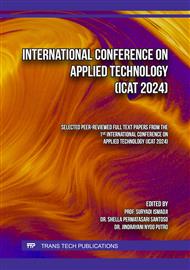[1]
A.E.G. Ginting and B.A. Dwiyantoro, "Studi Numerik Air Cooling dengan Perforated Straight Fins Heat Sink pada Central Processing Unit (CPU)," Jurnal Teknik ITS, vol. 12, no. 3, p.156 – 163, 2023.
DOI: 10.12962/j23373539.v12i3.127283
Google Scholar
[2]
A.W. Vidjabhakti, P. K. Purwadi, and S. Mungkasi, "Efficiency and Effectiveness of a Fin Having Pentagonal Cross Section Dependent on the One-Dimensional Position," Proceedings of the 1st International Conference on Science and Technology for an Internet of Things, 20 October 2018, Yogyakarta, Indonesia.
DOI: 10.4108/eai.19-10-2018.2282540
Google Scholar
[3]
K. Ginting, P.K. Purwadi, and S. Mungkasi, "Efficiency and effectiveness of a fin having capsule-shaped cross section dependent on the one-dimensional position," Proceedings of the 1st International Conference on Science and Technology for an Internet of Things, 20 October 2018, Yogyakarta, Indonesia.
DOI: 10.4108/eai.19-10-2018.2282543
Google Scholar
[4]
K. Ryanto, E. Tridianto, and W. N. Fadilah, "Studi Numerik Pengaruh Multiple Helical Fin terhadap Efektivitas Fin dari Modul Low Pressure (LP) Economizer," Proceeding Technology of Renewable Energy and Development Conference 3, vol. 3, no. 1, hal 41-47, 2023.
Google Scholar
[5]
M.F.A. Kafl and D.V. Wijanarko, "Studi Numerik Pengaruh Tipe Heatsink dan Fan terhadap Pendingin Dispenser Miyako," Jurnal Teknik Mesin, vol. 11, no. 3, p.83 – 92, 2023.
Google Scholar
[6]
M.M. Deoghare and K.R. Sontakke, "Heat Transfer Analysis of Winglet Type Fins Array Through Natural Convection," International Journal of Research Publications in Engineering and Technology, vol. 3, no. 1, p.4 – 8, 2017.
Google Scholar
[7]
M. Seen and J. Waluyo, "Karakterisasi PCM RT52 Kapsul Vertikal Pada Solar Water Heater Sistem Aktif," Prosiding Seminar Nasional Teknologi Industri Berkelanjutan III, vol. 3, (2023)
DOI: 10.31000/sinamu.v4i1.7879
Google Scholar
[8]
M. Seen, D. Purwadianto, G.A. Dyaksa, H. Winarbawa, Rines, S. Mardikus, W. Kusbandono and Y.B. Lukiyanto, "Characteristics of Straight trapezoidal Cross-Sectional Fins under Unsteady Conditions," International Journal of Applied Sciences and Smart Technologies, vol. 6, no. 1, pp.161-168, 2024.
DOI: 10.24071/ijasst.v6i1.7989
Google Scholar
[9]
P. Kamble, S.N. Doijode and G. Lathakar, "Experimental Study of Heat Transfer from Plate Fin Array in Mixed Convection Mode," International Journal of Innovations in Engineering Research and Technology, vol. 2, no.12, pp.1-11, 2021.
Google Scholar
[10]
P. K. Purwadi, B. Setyahandana, and M. Seen, "Efficiency and effectiveness of a fin having the ellipse cross section in the unsteady state condition", AIP Conference Proceedings, vol.2364, art. 030001, 2021.
DOI: 10.1063/5.0063541
Google Scholar
[11]
P.K. Purwadi, B. Setyahandana, and R.B.P. Harsilo, "Obtaining the efficiency and effectiveness of fin in unsteady state conditions using explicit finite difference method," International Journal of Applied Sciences and Smart Technologies, vol. 3, no. 1, pp.111-124, 2021.
DOI: 10.24071/ijasst.v3i1.3280
Google Scholar
[12]
P. K. Purwadi and M. Seen, "The efficiency and effectiveness of fins made from two different materials in unsteady-state," Journal of Physics: Conference Series, vol. 1511, no. 1, 2020.
DOI: 10.1088/1742-6596/1511/1/012082
Google Scholar
[13]
P. K. Purwadi and M. Seen, "Efficiency and effectiveness of a fin having the capsule-shaped cross section in the unsteady state," AIP Conference Proceedings, vol. 2202, art. 020092, 2019.
DOI: 10.1063/1.5141705
Google Scholar
[14]
P.K. Purwadi, Y. Angga, and S. Mungkasi, "Efficiency and Effectiveness of a Rotation-Shaped Fin Having the Cross-Section Area Dependent on the One-Dimensional Position," Proceedings of the 2nd International Conference of Science and Technology for the Internet of Things, ICSTI 2019, September 3rd 2019, Yogyakarta, Indonesia.
DOI: 10.4108/eai.20-9-2019.2292097
Google Scholar
[15]
P.S. Prabowo, S. Mardikus and E.C. Eukharisto, "Heat Transfer Characteristic on Wing Pairs Vortex Generator using 3D Simulation of Computational Fluid Dynamic," International Journal of Applied Sciences and Smart Technologies, vol. 3, no. 2, p.215 – 224, 2021.
DOI: 10.24071/ijasst.v3i2.3839
Google Scholar
[16]
W. Nuha, A.R. Nuha and M. Ikhlas, "Pengaruh Modifikasi Geometri Fins terhadap Performa Termal Heatsink Vertikal," Jurnal METIKS, vol. 3, no. 2, p.29 – 35, 2023.
DOI: 10.30598/metiks.2023.3.2.29-35
Google Scholar
[17]
Y.R. Aldori and Reno Pangesstu, "Analysis of Heat Flow Behavior on The Surface of The Heatsink Design Using ANSYS Software," IRA Jurnal Teknik Mesin dan Aplikasinya, vol. 1, no. 22, pp.11-17, 2022.
DOI: 10.56862/irajtma.v1i2.24
Google Scholar


